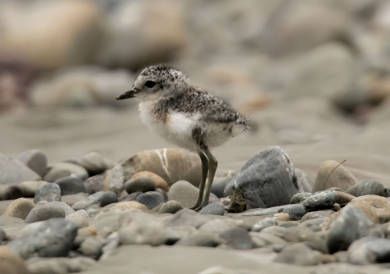Archived content: This media release was accurate on the date of publication.
Date: 24 September 2018

Banded dotterel chick
Image: Cleland Wallace ©
Sue Moore, Senior Ranger Biodiversity for DOC’s Manawatu District, says shorebirds such as banded dotterel and pied stilts will be seeking out nesting sites on rivers in the Rangitikei, Manawatu and Horowhenua.
These shorebirds are not as numerous as they once were. Their nest sites on gravel riverbeds are vulnerable to disturbance and predation.
“Breeding on a river bed is risky business. Nesting shorebirds have to contend with introduced predators, floods, and weeds encroaching on their nest sites,” says Moore. “We can help increase their chances of success by minimising disturbance from people and dogs.”
Eggs and chicks are highly camouflaged to help keep them safe from aerial predators (such as hawks). Unfortunately, it doesn’t protect them from threats on the ground, like hedgehogs, rats, stoats, cats, dogs, people, and vehicles.
Although nests can be difficult to spot, shorebirds will often leave their nest and fake an injury to divert unwanted attention from the eggs or chicks.
“Distraction displays are a good tactic, but if parents are away from their nest too long, eggs may get cold and die,” says Moore. “If you see a shorebird squawking and dragging its wing, there is a good chance it has a nest nearby so give it a wide berth.”
Here are a few tips for things you can do to limit disturbance and help nesting shorebirds:
- Keep noise to a minimum and don’t get too close. If you are still and quiet, you will get to see a lot more of their natural behaviour.
- Keep to marked tracks and paths wherever possible.
- Keep dogs on a leash – even well-trained dogs can scare or injure birds.
- Never dump garden waste or rubbish.
Shorebirds may be nesting and raising chicks from August to February. Locally, you are most likely to come across banded dotterel, black-fronted dotterel, pied stilt, and - if you are lucky - black-billed gulls.
Banded dotterel/tūturiwhatu (charadrius bicinctus) are a threatened species that breed only in New Zealand. They have a narrow black band on the neck and a wide chestnut band on the breast during the breeding season. Eggs are laid from August to early November in shallow scrapes lined with pebbles. They almost always produce three eggs, which are usually grey-green with small dark spots.
Pied stilts/poaka (himantopus himantopus) will also fake injuries to draw predators away from their nests. If this doesn’t work, they have been known to ‘dive-bomb’ intruders, swooping down from the air at great speed and making lots of noise to intimidate the enemy. They were quite common in New Zealand but their numbers are declining.
Tarāpuka or black-billed gulls have the unfortunate status of being the most threatened gull species in the world. Scattered populations in the North Island are usually found on sparsely vegetated gravel flats of riverbeds, such as the Manawatu River. If you see black-billed gulls nesting in that area please contact the Manawatu DOC office.
Contact
Kelly Hancock, Community Ranger
Mobile: +64 27 590 9231
Email: khancock@doc.govt.nz